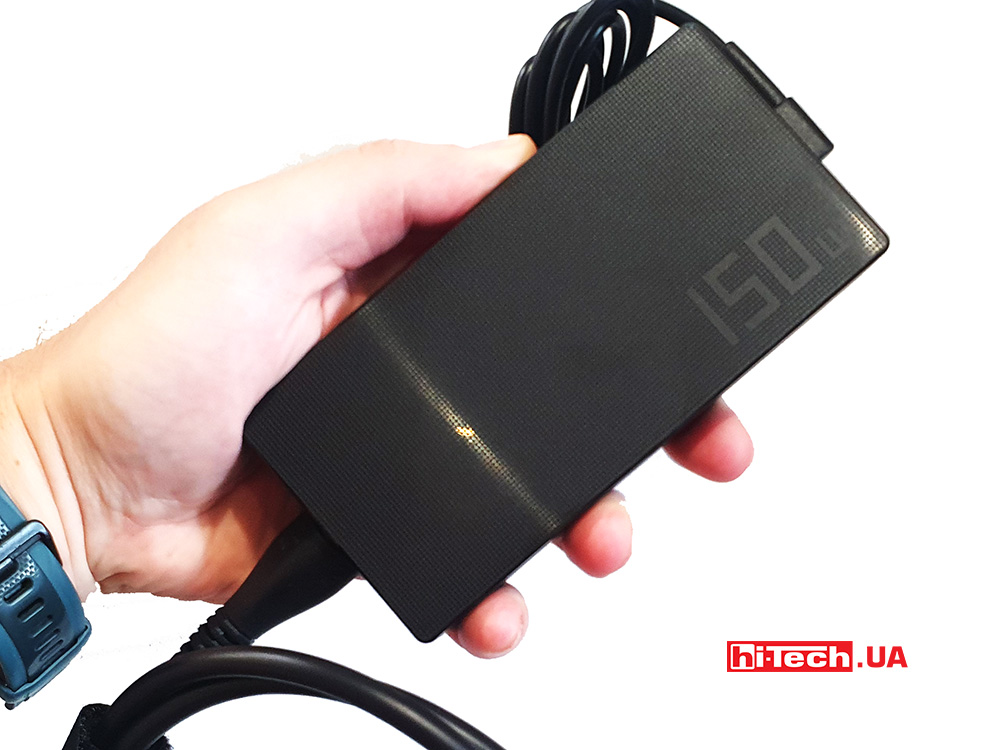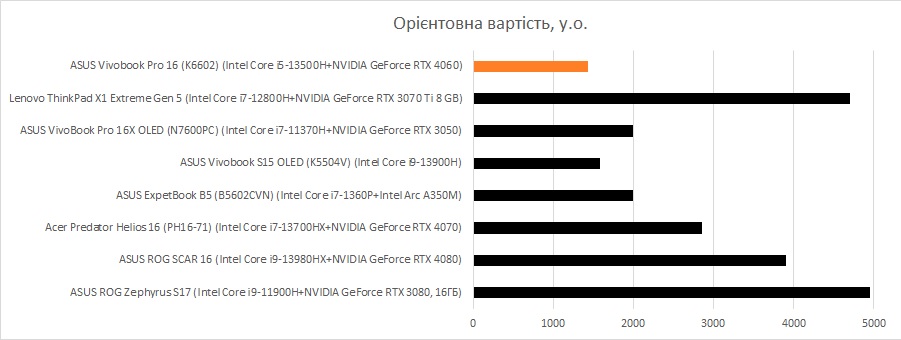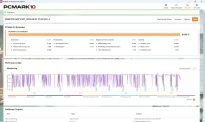ASUS Vivobook Pro 16 laptop test: average components across generations
14.08.23
In recent years, the cost of laptops with more or less acceptable characteristics has increased significantly, so we decided to find out whether relatively affordable models are worth the money and whether they can meet the needs of the average user.
Foreword
When testing gaming and work laptops, our editors, as a rule, dealt with models in top configurations. When there are no questions about power at all, the main subject of analysis becomes the cooling system and autonomy.
A review of models comes down to comparing already high performance in benchmarks; the conclusions of one or another stage are quite enough for working and editing media content, and the like. Secondary, but no less pressing questions are measuring temperatures under load, whether the laptop “takes off” and whether it is possible to be in the same room with it due to noise.
It is clear that in the case of powerful video cards, the issue of autonomy is not decisive, but the top U- and new P-processors from Intel compete in the number of hours of operation without an outlet, often exceeding the standard working day of 8 hours.
We wondered how more affordable models “feel” next to expensive laptops. In recent years, the cost of laptops with more or less acceptable characteristics for work and games at medium settings has increased significantly.
The best laptops for 300-400 dollars are used old devices, and for 700 we get processors with integrated video accelerators or similar discrete ones. And only with 1000 can you count on a processor with good energy efficiency and a discrete graphics card, which will allow you to comfortably play new games at medium or maximum speed in older editions.
About the laptop
The new ASUS Vivobook Pro 16 is a “moderate” and a kind of “people’s” laptop, which nevertheless still could not fit into the price of less, or at least $1000. ![]() Times like these.
Times like these.


It received a well-balanced set of components, including the latest thirteenth generation Core-i5, discrete video card 4060. In general, this is a model well known to our readers, which we tested in a variety of variations – both with a powerful Core i9-13900H without discrete, and with Core i7-11370H paired with GeForce RTX 3050.
![]()
![]() jpg" alt="ASUS Vivobook Pro 16 k6602" width="1000" height="750" />
jpg" alt="ASUS Vivobook Pro 16 k6602" width="1000" height="750" />
A similar set of hardware can be obtained in a gaming case, but for gamers chips of the Core-i7 level and higher will be minimally available there.


In terms of appearance, the Vivobook Pro 16 has the same laconic design with an embossed logo of the line on the outside cover, dense and non-marking surfaces of the body panels, an ergonomic keyboard with colored accents on different keys, a sufficient number of ports (several USB C, large HDMI 2.1 and Ethernet), which in our case are supplemented not just with a card reader, but with an SD card reader. As you have already realized, this chassis successfully accommodates and does not overheat both top-end mastodon processors and compositions with mid-low class video cards. ![]() It fit all the components and interface controllers without any adapters or dongles.
It fit all the components and interface controllers without any adapters or dongles.


Testing
Next, we decided to see what position the Vivobook Pro 16 occupies in terms of capabilities. Whether its Intel Core i5-13500X processor is enough for office tasks and normal workloads, or whether it becomes a bottleneck in games and creative tasks.
The NVIDIA GeForce RTX 4060 mobile graphics card is based on the AD107 GPU, has 3072 CUDA cores, a 128-bit memory bus and 8 GB of memory. Its TGP can reach 115 W, and in some models even 140 W.
Note that all testing was carried out in the most productive mode and at the highest possible frequencies specified by the manufacturer. ![]() The specified components in other models can be configured differently and give a difference in results of up to 30%.
The specified components in other models can be configured differently and give a difference in results of up to 30%.
Tsikakov made a comparison of our Vivobook Pro 16 and laptop models, not only of this line, but also others with processors of different performance levels and different video cards. Or without the latter.
We emphasize thatthe goal is not to compare specific models, but to demonstrate the achievements of components of different generations over time.
Results

The Essentials score in PC Mark 10 covers common, everyday uses of a PC. Workloads include web browsing, video conferencing, and program startup time. That is, here, in addition to the processor and video card, the performance of the drive also affects the result. Almost all models indicated in the histogram have modern NVMe SSDs with PCIe 4.0 x4 for 1 TB.
Despite the fact that the ASUS Vivobook Pro 16 (K6602VV) has a 512 GB drive, its result is one of the highest, at least due to the modern processor (12 cores and 16 threads), which has cores for different types of loads.

3DMark CPU Profile is designed to load the CPU at different thread levels while minimizing graphics load to ensure that graphics card performance is not the limiting factor.
With this more direct comparison, we see that the Core i9 model of the current generation (ROG SCAR 16) is obviously the most powerful, but the 12th (ThinkPad X1 Exteme) and 13th (Predator Helios 16) generation Core i7 have a slight parity.

PC Mark 10 Gaming simulates the experience of modern PC gaming. It includes real-time 3D graphics and many rendering effects. It includes two graphics tests that measure GPU performance, a physics test that measures CPU performance, and a combined test that stresses both the CPU and GPU.
Depending on the accelerator in these results is clear. According to the indicators, the leaders are 4080 (ROG SCAR 16), 4070 (Predator Helios 16) and 3080 (ROG Zephyrus S17). The gap between the 4070 and 4080 would have been even smaller based on their rated performance, but the 4080’s larger lead was provided by the Core i9 processor.
The RTX 4060 (Vivobook Pro 16) compared to the 3070 Ti (ThinkPad X1 Exteme) stands next to each other, and again, only the difference in the level of processors increased the difference in performance. The Mobile RTX 4060 can be compared to the Mobile RTX 3070 Ti and is capable of QHD as well as 4K in some games. In terms of energy efficiency, the mobile 4060 has a more balanced consumption than the 4080 and 4090, and compared to the same 3070 Ti it shows an improvement of about 20%.

The PCMark 10 Modern Office scenario measures battery life for light to medium office work. It includes a realistic balance of writing, web browsing, and video conferencing tasks separated by short periods of downtime. It is often said that continuous video playback stresses out a laptop in the same way. The numbers obtained are indeed similar, but we prefer automated tools to more accurately measure and record results.
Of course, this indicator is primarily affected by the battery capacity, and secondly by how intensively the processor and video card discharge it. The diagram clearly shows that models without video adapters (Vivobook S15 OLED) are far ahead of devices even with base-level discrete graphics (ExpertBook B5).

It is noteworthy that our guest today is confident in the numbers, not only due to new components. It is priced next to the models in its line (often more powerful) that we tested.
It wins even more in price among all the laptops under consideration during the period of their relevance. An irrespective comparison simply tells us that at the time of release on the market, the VivoBook Pro 16 (K6602) model is one of the most affordable. And the comparison of characteristics and price is much more interesting, because carries a code meaning. This was, in part, due to market circumstances, which have increased the cost of components in recent years. -shhe-na-5-10/”>although not all.
…vs price
Further comparisons would likely embarrass our fellow vendors. We, however, want to demonstrate how the cost of a laptop relates to its capabilities – collectively in terms of performance in various tasks (PC Mark Essentials) and separately for different processors and video cards.

Conclusions and impressions
There is only one conclusion here and it is not a revelation – the budget class of devices is the most widespread. This applies not only to laptops, but also to smartphones (especially them), smart clothing devices, accessories, and the same cars. Nowadays, “state employees” still do not have such a dramatic lack of capabilities compared to expensive models. Increasingly, high costs are due to nuances and details that are important to a limited number of users. But, of course, no one has canceled the algorithms, which are based on comparable hardware; they improve functionality and are only available in flagships.
At a time when smartphones already have decent processors even in the middle-low segment – they are enough for the Internet, instant messengers, social networks, in laptops today the shift in class is somewhat greater. It happened about 10 years ago, when the netbook class had already been forgotten in principle, Chromebooks were still too stupid, and the “ultrabook” tag meant that only this device would last more than 4 hours on battery power. Now there are laptops from the class “before” and “after” a certain price limit and “the ultimate hyper-duper solution in a body as thin as a napkin.”
Of course everything changes:
- Slowdown in the growth of computing capacity;
- A sharp increase in the volume of data (often small and monotonous, Big Data) that needs to be processed in real time;
- Geopolitical processes also somehow influenced the fact that today you cannot buy a decent laptop for $300.
We do not undertake to analyze current trends in society, sentiment and macroeconomic factors here. But it should be noted that marketers pay little attention to not the most expensive, but useful things. Or they are often undeservedly forgotten and little is said about them. How about this ASUS Vivobook Pro 16, which is worth every modern inflation dollar 😉


Characteristics of the ASUS Vivobook Pro 16 (K6602VV-N1016) laptop
| display: | 16”, 1920×1200 (16:10), 120 Hz, IPS, 300 bolt |
| Processor: | Intel Core i5-13500X, 12 cores, 16 threads, 2.6-4.7 GHz, 55 W |
| Video adapter: | NVIDIA GeForce RTX 4060, 8 GB GDDR6, up to 140 W |
| RAM: | 8 GB DDR5-4800 + 8 GB DDR5 SO-DIMM |
| Storage: | 512 GB PCIe 4.0 NVMe M.2 SSD |
| Connectors: | 2×USB Type-A 3.2 Gen 1, 2×USB Type-A 3.2 Gen 2, 1× Thunderbolt 4.1×USB Type-C 3.2 Gen 2 (PD: 100 W), 1 ×HDMI 2.1, Ethernet, Audio combined 3.5 mm |
| Webcam/microphone/LAN: | 1080p/yes/yes |
| Fingerprint sensor: | no |
| Communications: | Wi-Fi 6E 802.11ax, Bluetooth 5.2 |
| Keyboard backlight: | yes |
| Sound: | 2 DTS X Ultra speakers |
| Battery, power supply: | 70 Wh, 3-electron. Li-ion, 150 W |
| Additional: | SD card reader, US MIL-STD 810H protection |
| Operating system: | No OS |
| Dimensions: | 355×252×19 mm |
| Weight: | 1.9 kg |
| Supplier: | ASUS representative office in Ukraine |
| Price: | $1430 |
Rating:
+ price/performance
+ ergonomics
+ equipment
-breaks stereotypes about the cost of laptops
Read also about worthwhile:
Review of the wireless keyboard Epomaker EK68: its softness
Mouse review A4Tech Bloody R90 Plus: ambitious
Review of power banks from Xiaomi for 20 and 30 thousand mAh: important reserve
hi-tech.ua project manager
вологість:
тиск:
вітер:
ASUS ROG Zephyrus G16 (2024) laptop test: both worlds

ASUS ROG Zephyrus G16, with a top-end processor and a powerful graphics card, boasts more than compact dimensions. How the hybrid of an ultraportable and gaming laptop turned out – we’ll tell you in this article
A big sale has started in the Epic Games Store with discounts of up to 90%
games promoThe big 2024 Spring Sale has started in the Epic Games Store. The catalog includes games of all genres and settings
Realme Buds Air6 and Buds Air6 Pro wireless headphones
Bluetooth earphones RealmeRealme Buds Air6 headphones are equipped with 12.4 mm drivers and support Hi-Res audio stream with LHDC technology, as well as active noise cancellation (ANC).













